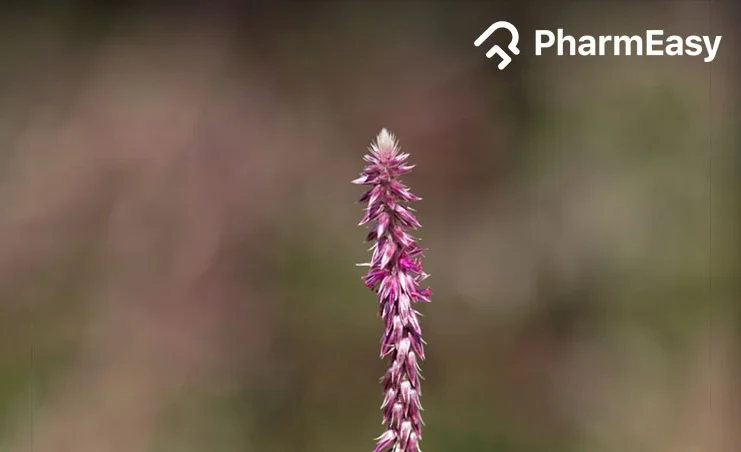Introduction
Achyranthes aspera is a perennial herb widely found in tropical regions and has been traditionally valued for its various uses in different cultural practices. Common names for the plant include chaff flower, prickly chaff flower, and devil’s horsewhip. All parts of the plant, roots, seeds, leaves, flowers, and fruits, have traditionally been used for various purposes, such as for eye conditions and heavy menstrual bleeding2. During Ganesh Chaturthi, the leaves are used in Ganesh Patra pooja3.
Morphology of Achyranthes Aspera
A. aspera (chaff flower) is an upright, spreading herb with many branches and a quadrangular stem. It is a perennial plant that can live for several years and usually grows up to 6–7 feet in height. The stem has noticeable longitudinal ridges or grooves with hairy nodes.
The leaves of Achyranthes aspera are simple, short-stalked, and covered with fine hairs. They grow opposite each other on the stem, which is sharp-pointed and woody. The upper surface of the leaves is green, while the underside is yellowish. Each leaf is about 8–10 cm long and 7–8 cm wide, with an egg-shaped broad base and a pointed tip.
The plant produces small green or yellowish-white flowers arranged in long, axillary spikes that can grow up to 60 cm in length. Flowering occurs throughout the year. By the time flowers bend towards the stem in the fruiting stage, the bracts (small leaf-like structures around the flowers) become sharp, pointed tips, making the heads spiny to the touch.
Fruits are orange to reddish-purple or straw-brown capsules, contain a single seed, and are produced throughout the year. The fruit easily attaches to clothes and animal skin1,2,4.
Where Is Achyranthes Aspera Found?
A. aspera is mainly found in tropical Asian, African, and warmer regions. It is also found in Australia and America, Ceylon, and Baluchistan. In India, it predominantly grows like a weed on roadsides4.
Chemical Components of Achyranthes Aspera
A. aspera contains the following key components:
- Fatty acids
- Oleanolic acid, triacontanol
- D-glucuronic, betaine
- Spathulenol, alkaloids
- Ecdysterone
- Achyranthine and various amino acids
- Oleonic acid
- Spinasterol, dihydroxy ketones
- Bisdesmosidic, triterpenoid-based saponins
- Saponin
- N-hexacos-14-enoic4
Nutritional Constituents
The plant A. aspera and its seeds contain carbohydrates, proteins, and several bioactive components, including flavonoids, saponins, and tannins, which may support overall health4.
Achyranthes Aspera or Chaff flower is highly nutritious and has caloric value. Based on some studies, it may have anti-diabetic activity and may be useful in managing diabetes11.
Dr. Siddharth Gupta, B.A.M.S, M.D (Ayu)
Other Names for Achyranthes Aspera
The plant is known by different names in various parts of India, as follows.
- Hindi: Puthkanda, Sonpur, Latjira, Lamchichra, Chirchira.
- Marathi: Aghada.
- Sanskrit: Apamargah.
- English: Chaff Flower.
- Punjabi: Kutri.
- Kannada: Gorwiballi, Karihambu.
- Tamil: Naaiyuruvi, Naagarkaai Mullu.
- Telugu: Uttaraene4.
Traditional Uses of Achyranthes Aspera
- The pulp prepared from fresh leaves and flowering spikes of A. aspera has traditionally been applied externally as a home remedy for scorpion stings.
- The seeds of the plant have been mentioned for use in certain eye conditions, including corneal problems, and are also described in relation to snake or reptile bites.
- The elongated flowering spikes, when mixed with a small amount of sugar, have been used in traditional practice for hydrophobia associated with dog bites.
- The ash obtained from A. aspera, which is rich in potash, has been used as a cleansing agent for washing clothes.
- The flowers and fruits of the plant are described in traditional texts as being helpful in managing heavy menstrual bleeding (menorrhagia)5.
Based on some research, A. aspera or Chaff flower might possess anti-fertility properties and might play a positive role in an unwanted pregnancy. However, its use should be in moderation and only after taking a professional opinion10.
Dr. Rajeev Singh, BAMS
Medicinal Uses & Benefits of Achyranthes Aspera
- Different parts of A. aspera, including its seeds, roots, and leaves, have been used in traditional practices for various purposes. The plant is noted for its strong, unpleasant odour when used either externally or internally.
- In traditional medicine, A. aspera has been attributed with several properties, such as expectorant (helps clear mucus), stomach tonic, laxative, anthelmintic (acts against intestinal worms), diuretic (promotes urine flow), lithotriptic (used for breaking down stones), sudorific (induces sweating), demulcent (soothes irritation), as well as anti-inflammatory, antifungal, antibacterial, anti-allergic, hepatoprotective (supports liver health), and other effects. Some studies also mention potential hypoglycaemic (blood sugar-lowering), antihyperlipidaemic (cholesterol-lowering), anti-asthmatic, anticataract, and anti-periodic fever (used against recurring fevers) activities3.
- Research on A. aspera supplements has explored their role in weight management, although the evidence remains preliminary6.
- The juice of A. aspera is described in Ayurveda as having astringent and anti-inflammatory properties, and it has traditionally been applied to ulcers and wounds to support healing.
- The root paste or juice of A. aspera has been used externally in folk medicine to ease pain, reduce itching, manage rashes caused by insect bites, and provide relief in urticaria (hives). It has also been used for earache.
- In some traditional practices, the daily use of powdered A. aspera mixed with honey has been suggested for improving digestion3.
- The plant has also been described in Ayurvedic texts as having digestive and appetite-enhancing qualities, which are believed to help maintain overall health.
- In Ayurveda, Apamarga kshara (alkaline ash prepared from A. aspera) is applied externally in the management of fistula and fissure.
- The oil derived from A. aspera has been used traditionally to reduce excessive cough and provide relief from respiratory discomfort3.
- The plant is also noted for its purgative (stool-softening) effect and is mentioned in relation to constipation, piles, and fistula/fissures.
- Animal studies on Wistar rats suggest that A. aspera extracts may help in the management of kidney stones by promoting urine output, though human evidence is lacking.
- Traditional texts also mention the plant’s role in supporting urinary health7,8.
- A mixture of A. aspera with tankana bhasma (a borax preparation) and lemon juice has been used to remove warts; however, since this can cause skin burns, it should only be attempted under medical supervision3.
- A. aspera, being naturally rich in potassium, is considered to be beneficial for heart health in traditional medicine3.
Side Effects of Achyranthes Aspera
A. aspera is generally considered safe when used in moderation, but may occasionally cause side effects like skin rashes and irritation5. If you notice symptoms after consuming A. aspera, you must consult your primary healthcare professional immediately9. As a precaution, it is important to consult a doctor before consuming this medicine to confirm whether it is safe for you.
Precautions While Using Achyranthes Aspera
- The paste made from A. aspera should be used carefully, as it may sometimes cause skin irritation or rashes. To reduce this risk, it is traditionally applied along with cooling substances such as ice.
- Consuming A. aspera in excessive amounts may lead to nausea and vomiting.
- During pregnancy and breastfeeding, the use of A. aspera is best done only under the guidance of a qualified medical practitioner.
- The use of A. aspera supplements is not recommended for children under 12 years of age5.
Also Read: Lavender: Uses, Benefits, Side Effects, Precautions & More!
Conclusion
Achyranthes Aspera is a traditional medicinal herb or weed all over India. Almost all the parts (seeds, roots, and shoots) of A. aspera are used to prepare traditional medicines.
A. aspera may support the management of boils, asthma, in facilitating delivery, bleeding, bronchitis, debility, dropsy, cold, colic, cough, dog bite, snake bite, scorpion bite, dysentery, earache, headache, leukoderma, renal complications, pneumonia, and skin diseases.
Also Read: Aloe Vera: Uses, Benefits & Side Effects
Frequently Asked Questions (FAQs)
Can Achyranthes Aspera help in menstrual disorders? Yes, traditionally, A. aspera is used for menstrual disorders like dysmenorrhoea. However, there is limited scientific evidence to prove this effect.
Is Achyranthes Aspera supplement helpful in wound healing? A. aspera supplements may support wound healing due to their tannin content, which is known to have astringent and anti-inflammatory properties. A. aspera supplements may also help improve blood flow to the wound. This synergistic effect may support faster wound healing.
Is Achyranthes Aspera (Apamarg) used in the treatment of ulcers? A. Aspera supplement may support ulcer management as it contains a mixture of anti-ulcer and gastroprotective bioactive compounds. A. aspera supplements may be helpful in lowering the volume of gastric juice and total acidity, thereby increasing the pH of gastric juice. This may help in managing ulcer-related problems.
Reference
- Srivastav S, Singh P, Mishra G, Jha KK, Khosa RL. Achyranthes aspera — An important medicinal plant: A review. J Nat Prod Plant Resour. 2011;1(1):1–14. Available from: https://www.scholarsresearchlibrary.com/articles/achyranthes-asperaan-important-medicinal-plant-a-review.pdf
- Salam MA, Ahmad A, Sadiq F, Tariq TF, Rasheed N, Shah MA, Aarab M, Anwar M, Khurram M. Assessment of phytochemical and pharmacognostic properties of flowers of Achyranthes Aspera. J Popul Ther Clin Pharmacol. 2023;30(17):743–55. doi:10.53555/jptcp.v30i17.3727. Available from: https://jptcp.com/index.php/jptcp/article/view/3727
- Sonar S, Bhandari D, Patil N, Bhor S, Jogdandkar O, Chamnar P. Spiritual medicinal plants. World J Pharm Res. 2022;11(16):2137–55. doi:10.20959/wjpr202216-26435. Available from: https://www.wisdomlib.org/uploads/journals/wjpr/volume-11,-december-issue-16_21007.pdf
- Ghorpade K, Badadhe S. The effectiveness of chaff flower against snake bite (Achyranthes aspera). Int J Pharmacogn Clin Res. 2023;5(1):16-21. doi:10.33545/2664763X.2023.v5.i1a.26. Available from: https://www.pharmacognosyjournal.in/archives/2023.v5.i1.A.26/the-effectiveness-of-chaff-flower-against-snake-bite-achyranthes-aspera
- Nisarga P, Prashanth Kumar HP. Achyranthes aspera (Devil’s horsewhip): An overview. Conference Proceedings (ICGCP). Available from: https://sapthagiri.edu.in/designs/naac/ICGCP/BT_CHE.pdf
- Rani N, Sharma SK, Vasudeva N. Assessment of Antiobesity Potential of Achyranthes aspera Linn. Seed. Evid Based Complement Alternat Med. 2012;2012:715912. doi: 10.1155/2012/715912. Epub 2012 Jun 27. Available from: https://pubmed.ncbi.nlm.nih.gov/22919417/
- Rajeshwari T, Suresh R, Sudhakar M. Anti-urolithiatic activity of saponin rich fraction from the methanolic extract of Achyranthes aspera against ethylene glycol induced urolithiasis in Wistar rats. J Appl Pharm Sci. 2023;13(09):197–203. doi:10.7324/JAPS.2023.144912. Available from: https://japsonline.com/admin/php/uploads/4032_pdf.pdf
- Warke PD, Upadhayay A, Kale MK. Evaluation of diuretic activity of Achyranthes aspera leaves extracts. Res J Pharm Technol. 2018;11(12):5394–6. doi:10.5958/0974-360X.2018.00984.8. Available from: https://rjptonline.org/AbstractView.aspx?PID=2018-11-12-33
- Ghimire K, Banerjee J, Gupta AK, Dahal P. Phytochemical constituents and pharmacological uses of medicinal plant Achyranthes aspera: a review. World J Pharm Res. 2015;4(1):470–89. Available from: https://wjpr.s3.ap-south-1.amazonaws.com/article_issue/1420092687.pdf
- Shibeshi W, Makonnen E, Zerihun L, Debella A. Effect of Achyranthes aspera L. on fetal abortion, uterine and pituitary weights, serum lipids and hormones. Afr Health Sci. 2006 Jun;6(2):108–112. PMCID: PMC1831979. PMID: 16916302. Available from: https://pmc.ncbi.nlm.nih.gov/articles/PMC1831979/
- Rehman R, Melki D, Shehzad A, Nadeem F, Khalid T. Commercial Importance, Medicinal Value and Therapeutic Potentials of Chaff Flower (Achyranthes aspera) – A Review. Int J Chem Biochem Sci. 2018;14:62-70. Available from: https://www.researchgate.net/publication/336825207_Commercial_Importance_Medicinal_Value_and_Therapeutic_Potentials_of_Chaff_Flower_Achyranthes_aspera_-A_Review
Disclaimer: The information provided here is for educational/awareness purposes only and is not intended to be a substitute for medical treatment by a healthcare professional and should not be relied upon to diagnose or treat any medical condition. The reader should consult a registered medical practitioner to determine the appropriateness of the information and before consuming any medication. PharmEasy does not provide any guarantee or warranty (express or implied) regarding the accuracy, adequacy, completeness, legality, reliability or usefulness of the information; and disclaims any liability arising thereof.
Links and product recommendations in the information provided here are advertisements of third-party products available on the website. PharmEasy does not make any representation on the accuracy or suitability of such products/services. Advertisements do not influence the editorial decisions or content. The information in this blog is subject to change without notice. The authors and administrators reserve the right to modify, add, or remove

























Comments